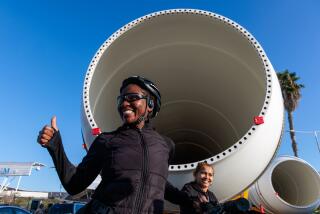Launch Site in Jungle Takes Shape : Space: A massive new center rises out of the Amazon wilderness as a consortium of nations prepares to send its first astronauts into orbit.
- Share via
KOUROU, French Guiana — Thousands of tons of concrete are being poured into a vast clearing of the Amazon jungle as Europe’s challenge to superpower supremacy in space takes shape.
Like an Aztec pyramid rising from the tropical forest, a virtual city of buildings is growing in this French territory in South America to build and launch Europe’s first manned space mission.
“This is the biggest European building site after the (English) Channel Tunnel construction project,” said Jean-Marc Arthaud of the French space agency, which has overall responsibility for erecting the new space center.
A 725-ton Ariane 5 rocket is scheduled to carry astronauts into orbit aboard the Hermes spaceplane before the end of the century.
The project dwarfs nearby launch pads from which four generations of unmanned Ariane rockets have blasted into space since the first launch in 1969.
“It’s on a completely different scale,” said Charles Bigot, chairman of Arianespace, the company responsible for marketing and launching the rockets.
French space officials delight in tossing out statistics during a 90-minute tour around the new installation, which stretches over a 20-square-mile area carved out of jungle and savanna near the Atlantic coast.
“Four million cubic meters (140 million cubic feet) of earth have been removed, half a million cubic meters (18 million cubic feet) of granite has to be blown out with dynamite, and we are building the biggest mixing bowl in the world,” Arthaud said.
The “mixing bowl”--large enough to produce 48,000 loaves of bread at once--will blend 200 tons of two highly volatile blocks of chemicals to produce the solid fuel that will power the rockets.
The largest project completed so far is a massive test bed gouged out of the granite bedrock--200 feet deep and 655 feet long--for the rockets that will be used to launch the Ariane 5 in 1995.
Concrete blocks weighing 1,000 tons will be used to hold down the rocket motors during the tests, and engineers expect surrounding granite to vitrify during the two-minute-long burns, which are vital before astronauts risk their lives.
Construction is going ahead while, back in Paris, arguments rage over the ultimate objectives of the Hermes spaceplane, which is about half the size of the U.S. space shuttles.
The European Space Agency, which groups 13 countries, gave the go-ahead in 1987 for $1.8 billion to build the factories, test beds, launch pad and control center at Kourou.
Apart from the keenly sought European prestige of being able to send people into space, doubts remain over Hermes’ mission.
The 1986 explosion of the U.S. shuttle Challenger sent European designers back to the drawing board for an expensive redesign of their spaceplane.
Ejection seats will be added, and designers have dropped plans for Hermes to have its own rocket motors. The Ariane rocket will now power it into orbit. Like the U.S. shuttles, it will glide back to Earth without power.
Hermes is scheduled to dock with the U.S. space station Freedom, a project slowed by the 1986 Challenger disaster, and ESA has now signed an accord with Moscow for Hermes to dock with the Soviet space station Mir as well.
Critics say that Hermes is too small to launch commercial satellites and that technology is getting so sophisticated that astronauts are becoming superfluous.
The Ariane 5, which will match the biggest U.S. and Soviet launchers for size and power, will be partly built in French Guiana, bringing unprecedented work to this isolated outpost 4,000 miles from Paris.
About 1,500 people--half of them French Guianese--work on the project at the moment, underlining the social pressure caused by the presence of an industry at the cutting edge of high technology in what separatists call a Third World colony.
Local labor unions halted work on the project earlier this year to protest working conditions for foreigners, mainly Brazilians.
A drive around the huge building site makes clear that thousands of trees have been felled, but officials point out that the space agency is spending $380 million on environmental protection.
ESA officials say Hermes is scheduled to land in southern Spain after completing its mission, although French Guiana’s main airport at Cayenne would probably be extended to provide an emergency landing strip.
The first manned flight of a Hermes spaceplane perched atop the Ariane 5 rocket--as opposed to the U.S. and Soviet shuttles, which cling onto the side of boosters--is scheduled to take place in 1999.
France, with 43.5%, is the biggest investor in the project. Britain, voicing doubts from the outset, refused to invest at all.
More to Read
Sign up for Essential California
The most important California stories and recommendations in your inbox every morning.
You may occasionally receive promotional content from the Los Angeles Times.













